

Aaron Lane can be placed on the Mojave River as early as December 1858, at which time a theft took place on his property. The crime is noted in a letter dated December 16, 1859, from Brevet Major James Henry Carleton, First Dragoons, at Fort Tejon, to Major W. W. Mackall, Assistant Adjutant General, in San Francisco.
Carleton was writing to request the dishonorable discharge of two soldiers in his Company K because of thievery, one of whom was the culprit who stole from Lane:
Private John Higgins of this company enlisted as a soldier at San Francisco, Cal, on, or about the 16th of last February. Some days afterwards, as he admits, and as can be proved by Col Hoffman, Lieut Corley, and other officers, he was arrested by the Civil Authorities of San Francisco, was tried and convicted and sentenced to one hundred and twenty days imprisonment for stealing. The man also admits that he stole from his employer, a Mr. Lane, living on the Mojave river, twenty dollars and run off. This was in December previous to his enlistment (December 1858). This theft can be proved. |
The $20 theft by Higgins was something Lane could ill afford. Although relatively minor in nature, this was the first of several misfortunes to befall him in the years to come. In spite of these adversities, however, his move to the desert proved to be permanent; he spent the next 25 years residing on the Mojave River.
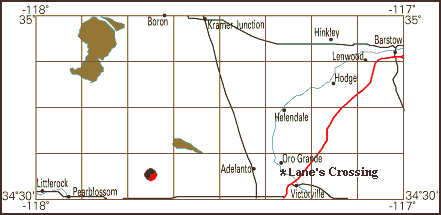
DESERT LAND AT BARGAIN RATES
Lane had moved to the Mojave at a time when desert land was being offered by the government at very low prices. In the spring of 1858, it had been announced that on instructions of the Commissioner of the General Land Office, there was to be a sale of public land in the San Bernardino area, including thousands of acres on the desert.
Despite the fact that the sale included some very desirable farmland, not one bid was received by the government, and not one person showed up for the auction. The problem apparently stemmed from a lack of maps. Prospective buyers had gone to the Land Office to determine which properties were being offered, but without maps they were unable to do so and they left in disgust.
Word was then leaked that land could now be obtained at bargain rates by "enterprising individuals." Without doubt, Lane fit that description, and since the San Bernardino valley climate did not suit him, he used the opportunity to lay claim to property at the upper crossing in Sections 30 and 31, Township 6 North, Range 4 West, San Bernardino Meridian. He also probably took advantage of the "swamp and overflowed land" act of California, which allowed settlers to purchase land on a credit of five years.
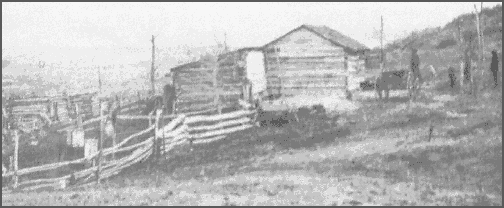
A SETTLEMENT ON THE MOJAVE
From various sources it is known that Aaron was not alone at the crossing. The census shows there were ten people living in two residences on the river by 1860. Listed in Dwelling No. 703 were Aaron Lane, William R. Levick, and the Nicholson family, consisting of George and Frances, and their three children aged 9 to 13. Joseph and Mary Highmoor lived in Dwelling No. 704, with a seven-year-old female named Anna.
In January of 1860 the newspaper, referring to this small group, announced that a settlement was being formed on the Mojave and that "good locations are known to exist." In April of the following year another "settlement" was reported to be in existence:
On the Mojave river settlements are springing up. The tide of travel is carrying along the hardy and industrious pioneer, with his family, who is now erecting his home on the banks of the river. Fine tracts of arable land exist there, and already broad fields present their luxuriant grain to the astonished gaze of the weary traveler. Fine springs of water thread their silvery course, affording joy and refreshment to the wayfarer, ere lost in the sands of the desert. |
Although the author of this article indulged in some rather fanciful rhetoric, it can be seen that he only is referring to a single residence being built on the river for one family. This was most likely the Nicholson home at Point of Rocks, as that property appears on the tax assessment records for 1862, and there are no other candidates.
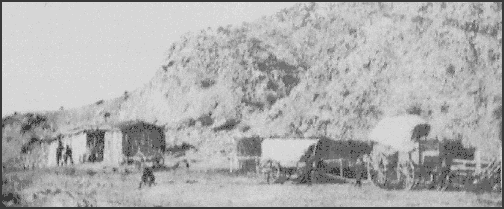

Contrary to the author's idyllic description, Lane and the other few settlers had chosen harsh country in which to make their livelihoods, and they spent their days in danger from numerous sources. Indians, rustlers, horse thieves and other desperadoes made existence precarious on the river well into the 1860s.
OUTLAWS CAPTURED AT LANE'S
One constant threat on the Mojave came from the criminals in the California southland who sought to avoid capture by escaping through Cajon Pass and out into the desert. A potentially deadly incident took place at Lane's in March of 1859, when a deputy sheriff and posse trailed a dangerous criminal to the upper crossing.
Undersheriff H. E. Lewis and Police Officer W. C. Warren, both of Los Angeles, had tracked a suspect by the name of Wade Helm to Agua Mansa. Helm was wanted statewide for the vicious murder of a miner, and the governor had offered a reward for his arrest. Losing the trail in Agua Mansa, the officers continued on to San Bernardino, and upon inquiry were told the suspect had been seen at Martin's Ranch in Cajon Pass.
After recruiting two local citizens and acquiring fresh horses from Cajon toll road owner John Brown and another man, they headed out to Martin's, where they learned that their quarry had spent the night at the ranch and had left that morning. The posse followed the tracks of Helm's horse, which led them to Lane's way station.
Helm and an accomplice named Mace were inside the station when the posse arrived, and the two came out with pistols "drawn and cocked." At this point it looked like a gun fight was inevitable, but Deputy Lewis skillfully defused the situation and arrested Helm and Mace without bloodshed.
INDIANS RAID THE SETTLEMENT
Shortly following this episode, Lane fell victim to an Indian attack. At the time the attack occurred the Indians at the Mohave Villages had not yet been subdued. It was in May 1859, less than a month after Colonel Hoffman made his ineffective truce with the Mohaves, that news was received of the raid at Lane's Crossing:
INDIAN DEPREDATIONS -- A band of Mojave Indians made a descent upon Lane's Fort, at the crossing of the Mojave river. They overpowered Mr. Lane, and others living at the Fort, and then ransacked the houses, dispossessing the occupants of all their worldly goods. Surely it is high time that our Government should adopt some efficient means to prevent these Indian outrages, that are daily being committed in our midst, and afford that protection to our citizens which is guaranteed to them by the Constitution of their country. |
It is unclear whether the report is
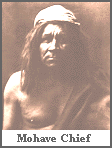 referring to the Mohaves themselves or to an unspecified tribe
of Indians from the Mojave Desert. If it were indeed Mohaves
who raided Lane's ranch, he was fortunate not to have lost more
than his worldly goods. These Indians were fierce and used to
having their way out on the desert. It was the Mohaves who
left the trail of bodies which Father Nuez discovered on this
very stretch of road in 1819.
referring to the Mohaves themselves or to an unspecified tribe
of Indians from the Mojave Desert. If it were indeed Mohaves
who raided Lane's ranch, he was fortunate not to have lost more
than his worldly goods. These Indians were fierce and used to
having their way out on the desert. It was the Mohaves who
left the trail of bodies which Father Nuez discovered on this
very stretch of road in 1819.
There were other hostile Indians who could have made the attack on Lane's, including the Chemehuevis from the Colorado River region, some of whom wintered in the town of San Bernardino and were known to resent the intrusion of the white man. It is more likely, however, that the raid was made by Paiutes. This group of Indians was the most active in the area in the years prior to, and for a period of years after, Lane's arrival at the upper crossing.
MAN DIES AT LANE'S FROM ARROW WOUNDS
It was Paiutes who were believed to have committed several killings on the desert during the early part of 1860. The first incident occurred in January. A band of Paiutes had stolen some cows and horses from a herd in the vicinity of "the Vegas", and a party was sent to recover the stock. One of the men who went in search of the cattle was attacked by Indians, and was already dying from arrow wounds by the time his companions found him.
In February, the commander of Fort Tejon, Colonel B. L. Beall, detailed a squad of First Dragoons to pursue the Indians. Lieutenant Carr and 25 men were directed to proceed out Soledad Pass and then across the desert to Cajon Pass to search for Indians who had been stealing horses in that area. From there they were to continue "out to the Mojave, the scene of the late murder, down the river to Lane's crossing." Carr stated arrogantly that he would "thoroughly chastise the rascals who have been committing such depredations...."
If Lieutenant Carr thought a quick pass through Indian country with a squad of 25 troops was going to suppress the Indians, he was quite mistaken. The very next month well-known merchant Thomas Williams and his brother-in-law, Parmeno Jackman, were slain on the Mojave Desert while bringing a train of wagons into California, for the purpose of hauling freight back to Utah.
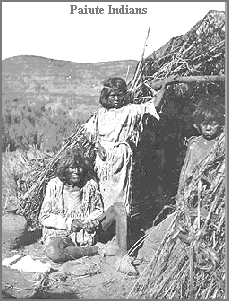
Their party, made up of teamsters and a number of passengers, had reached Dry Lake when Williams and Jackman left the train and rode ahead to look for water and forage. They came to Bitter Springs, where they joined with four Paiute Indians who guided them to a grazing area a few miles away.
Not expecting trouble, since the Indians along the trail had all seemed friendly, the two men had left their guns behind with the wagon train -- an unwise thing to do in the desert under any circumstances, and in this instance a fatal mistake on their part. On their way back to Bitter Springs, the Indians began shooting arrows into them. Helpless without firearms, the men spurred their horses toward the road in an attempt to escape.
Both men were mortally wounded, but Williams was carried back to camp by his horse and the alarm was raised. A party was formed and went in search of Jackman, and when they found him he was nearly dead from his injuries and the extreme cold. Williams died later that day and Jackman was taken to Lane's for help. "Mr. Williams," the Los Angeles Star reported, "was buried at Bitter Springs, and Mr. Jackman was brought to Lane's ranch on the Mojave, where he receives every care, but his wounds are of such a nature that no hope of his recovery is entertained."
Dr. Alonzo Ainsworth came from San Bernardino to attend to Jackman, who was "lying at Lane's...in a most critical condition." Mr. Jackman was moved to the home of the doctor, and died there April 19th, after a month of continual suffering.
DRUNKEN SHOOTING ENDS IN DEATH
Jackman's death followed on the heels of another tragedy that had occurred at Lane's Station only a couple of weeks earlier, except on this occasion there were no Indians involved. Several recently discharged Army soldiers from Camp Floyd, Utah, together with some teamsters, had come into California across the Mojave, and on their way through they stopped at the way station for some refreshment.
The group was later joined by a man named Joel H. Brooks, a civilian employee of Army Quartermaster Captain Winfield Scott Hancock and a frequent traveler on the desert. Brooks was a troublemaker who had been adjudged to be a person of "poor" character several years earlier in a government report.
It appears that all the men had refreshed themselves with a good deal of liquor that day, and a drunken argument broke out between Brooks and the others. Brooks stepped outside and said that he would shoot anyone who followed. Unfortunately, one man staggered out after him and was shot in the arm. The victim, a discharged soldier from the 7th Infantry Regiment by the name of Charles O'Donnell, died on March 31, 1860, from "mortification," or gangrene, which apparently resulted from improper medical care by the doctor who was treating him.
Lane took care of O'Donnell for two days before his death, and then saw to his burial. For these services, and others specified in a bill submitted to the Probate Court, Lane asked for a reimbursement of $38. For the kindness shown, O'Donnell gave Lane his pistol before he died.
Brooks had fled the area following the shooting, but in July he surrendered himself to San Bernardino authorities. He was acquitted on the grounds of self-defense, and it was also found that the wound was not necessarily fatal, and that O'Donnell had died of malpractice.
It was Dr. Ainsworth who had attended to O'Donnell, and he subsequently became involved in a dispute with the court over his refusal to return $140 in cash that O'Donnell had on him when he died. Despite repeated requests from Probate Judge A. D. Boren, Ainsworth would not part with the money and was eventually thrown in jail for contempt. The probate records do not state why Dr. Ainsworth refused to return the money, nor do they give the outcome of the dispute.
CAMP CADY ESTABLISHED
As can be seen from these accounts, Lane was in the midst of the action. Indian attacks and killings were taking place all around him, and even in his own home, yet he stuck it out; others on the desert in the 1860s left for safer country.
The Indian attacks had become such a problem that the military finally sent Major James Henry Carleton to deal with the situation. In April, Carleton established a base of operations, known as Camp Cady, about ten miles below Forks of the Road at a spot where the Mojave River surfaces. This was a boon for Lane; the military camp afforded some security, plus it needed supplies, so he was able to obtain hard cash through the sale of hay and other crops.

THE CAMEL EXPRESS
In September of 1860, Aaron once again found himself in the center of activity when the camel "express" came by his ranch. Edward Beale had experimented with the capabilities of camels when he pioneered a wagon road through the Arizona desert in 1857, and had advocated the use of them.

American soldiers, miners and teamsters loved the U. S. mule and thoroughly despised the camel. They made every effort to make the camel experiment fail, and they had many allies, including the press. Their antipathy toward these animals is understandable. Camels were harder to load, their breath was foul and they spat. They were known to bite, and they frightened the mules and horses; also, they cost $1200 each. So even though Edward Beale gave a good recommendation for their use, camels fell out of favor.
In 1859 Captain Winfield Scott Hancock had been assigned to supply the newly created Fort Mojave on the Colorado River, and he decided to give the camels another try with an express between Los Angeles and the fort. The September 22, 1860, Star called it the "dromedary line," and stated that Hancock "dispatched a Greek and a camel on the trip." John Jones, a young Welsh immigrant who worked as a government express rider, was the informant for this story from September 29th, which reveals the prejudice against the camels:
The movements of this "ship of the desert" do not seem to come up to the expectations formed of it, by some persons. The mule express messenger, on his return from the river, spoke the "craft" at Lane's crossing of the Mojave, about 100 miles from here, out two and a half days, and apparently in no very good "sailing" condition. |
The reporter believed that the trip would be completed without further distress, but Jones was of a different opinion. He stated his mules made the journey in four days and that the rate of the camel was only about 35 miles a day, which meant an eight- or nine-day trip, based on 1859 mileage charts (Major Samuel P. Heintzleman had calculated the distance from Los Angeles to the Colorado River as 320 miles. A freighter by the name of Joseph Winston charted it at 285.71). Even with the disparity in calculations, and allowing that expressman Jones may have exaggerated his speed just a bit, the advantages of the mules are obvious.
The final chapter in the camel story came on October 6th, with the reporter still using his sailing metaphors. The "ship of the desert," he wrote with evident glee, "foundered at sea last week, going down with all hands." The hapless camel had died of exhaustion a short distance from Lane's Crossing. As far as the reporter was concerned, the mules were still favored, and he concluded derisively, "Uncle Sam had better try his new fangled 'conveyance' on some other line."

MILITARY RENIGS ON PEACE TALK PROMISE
Throughout the summer months of 1860, up until the time of the camel fiasco, there had been a cessation of Indian hostilities. On July 2nd, Major Carleton had held a peace talk with the Paiutes and told them what was expected of them. He also told them that if they kept their promises, other soldiers would come in the fall and give them presents. The next day, July 3rd, Carleton closed Camp Cady and he and his troops left the area.
October arrived with no presents, and the Indians became unsettled again. The newspaper complained that Colonel Beall needed to send some troops out to the desert again to remind the Indians of what was in store for them if they did not keep on their good behavior.
The Paiutes had believed Carleton when he told them that soldiers would return to the Mojave River with gifts. When they failed to do so, the Indians stopped an express rider and told him they were waiting for the Major to fulfill his promise. They next stopped Joseph Winston's freight train and threatened to attack it when it came through again. The Paiutes told the freighters they thought Carleton was afraid to come back. Carleton was informed of this, but he did not want to get involved, and told his superior, "I am not a volunteer...to council with, or to fight the Pah Utes."
Winter arrived, but the troops still had not been sent to the desert, nor would they be for quite some time. With the beginning of 1861 the attention of Carleton and other soldiers became focused on the events that were to lead to the Civil War. When Fort Mojave was abandoned in May 1861, the Paiutes were reinforced in their thinking that they were winning their war with the whites. During the next few years, this attitude made things very hazardous for the handful of settlers living on the Mojave River.

 PAGE
1|
2|
3|
4|
5|
6|
7|
8|
9|
10|
11|
12
PAGE
1|
2|
3|
4|
5|
6|
7|
8|
9|
10|
11|
12

